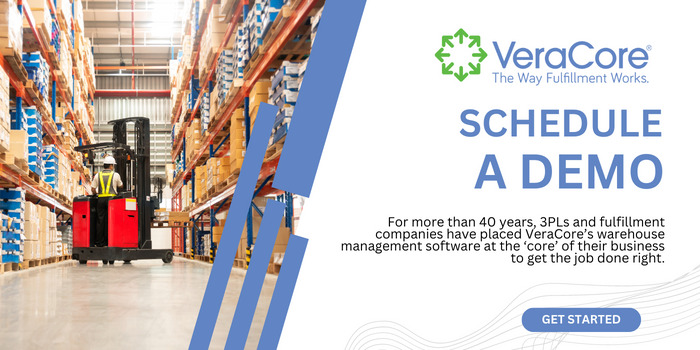Effective returns management can help your 3PL stand out, alleviating client stress and improving customer satisfaction. However, your processes can positively or negatively impact your client’s returns. It begins with accuracy in fulfilling orders and ends with an efficient approach to simplify returns to improve customer satisfaction. Here, we look at ways to help improve accuracy and streamline the returns process to create a positive 3PL client experience.
Warehouse Management System Integration
A WMS provides visibility through receiving, packing, shipping, delivery, billing, and returns, making tracking inventory and orders easy. For end-to-end support, you can integrate your WMS with returns management, shipping and carriers, and accounting/enterprise resource planning (ERP) platforms. However, where a WMS really helps is at the ordering stage.
You can help your clients reduce customer returns with accurate picking and packing. Your WMS, in hand with scanning technology, improves the picking and packing process, reducing the risk of mispicks that lead to returns and decreased customer satisfaction. A WMS improves oversight of complex orders to minimize the need for returns in the first place.
Help Increase Customer Lifetime Value
Returns are expensive without an effective returns management process. Part of those costs includes the risk of losing a long-time customer due to an inconvenient returns policy. Creating a streamlined process that reduces return costs while maintaining customer loyalty ensures your clients enjoy improved customer lifetime value through future purchases. Accuracy in orders and a customer-centric returns policy improve customer trust, building longer-term relationships.
Reduce the Cost of the Returns Process
Often, the challenge is ensuring that returns and refunds don’t cost your clients more than the resale process. You can help reduce costs and the impact of returns on your warehouse by recommending the following returns policies for clients:
- Extending the return time frame: Extended time frames appeal to customers. However, they also increase the odds that the customer will change their mind, keep the item, forget about the return, and miss their deadline.
- Allow in-store or warehouse returns: Instead of contending with shipping costs, allowing shipped orders to be returned at the store or warehouse level works well for omnichannel retailers. This eliminates shipping costs, increases the possibility of reselling the item due to a reduced risk of damage, and increases the possibility of the customer making a new purchase when making in-store returns.
- Track the costs of refunds and returns: Transparency in processing returns allows your clients to decide whether it is more cost-effective for them to provide a refund without the need to return the product.
- Free return shipping and labeling: Free shipping and automated return labels make it easy for customers to make returns. Although charging customers to return items is a cost-saving, it can contribute to customer dissatisfaction and errors that ultimately cost more. This approach creates an effective returns policy that is easier for customers. However, it also helps protect returned items from damage in transit so they can be returned to inventory for resale.
Introduce Reverse Logistics Technology
Reverse logistics technology makes tracking returns, monitoring reverse logistics, and improving inventory accuracy easier. Return management tools improve your warehouse management accuracy by having a simple returns policy while also helping avoid returns. You can introduce quick processes that maintain better control and improve visibility.
It also ensures clients have a clearly defined return policy and procedure (RPP) shared with customers and strictly adhered to by staff. This helps avoid time-consuming approvals for customized customer returns. Reverse logistics creates a more efficient flow of goods, reducing costs, decreasing the risk of errors, and providing more value to your clients and their customers.
Create a Warehouse Return Center
Return centers control returns processes in a designated area managed by an established team. This includes:
- Quality control assessments
- Refurbishment when applicable
- Repackaging
- Putaways
You avoid disruption to the rest of the operations and improve inventory accuracy. However, when clients have complicated returns policies with quality control assessments, you also help your clients improve potential resale profits while ensuring customers receive their refunds promptly.
Use Scanning Technology
Scanning returned inventory during the putaway process streamlines returns and improves accuracy. You can also use scanning to indicate relocation areas for your crew to avoid errors in placement. Scanning helps get inventory back into circulation for faster resale, improving customer satisfaction by keeping more stock available. You can also set criteria for accepting returns based on the reason for the return, the product’s condition, or details such as the expiration date.
As you can see, efficient returns management simplifies the process to help improve customer satisfaction. Introducing customer-friendly returns policies and using a WMS to oversee returns helps create a better customer experience.


VeraCore is SaaS order and warehouse management software trusted by top fulfillment companies and 3PLs. Affordable, flexible, easy to use; VeraCore is everything you need to keep clients happy and run a lean operation.
With VeraCore, you can grow your business and handle any challenge with ease. Rules-based automation enables you to control all aspects of your warehouse operation and satisfy each of your clients’ unique requirements.
Hundreds of fulfillment service providers and 10,000+ fulfillment clients place VeraCore at the “core” of their business to get the job done right, for over 40 years.


